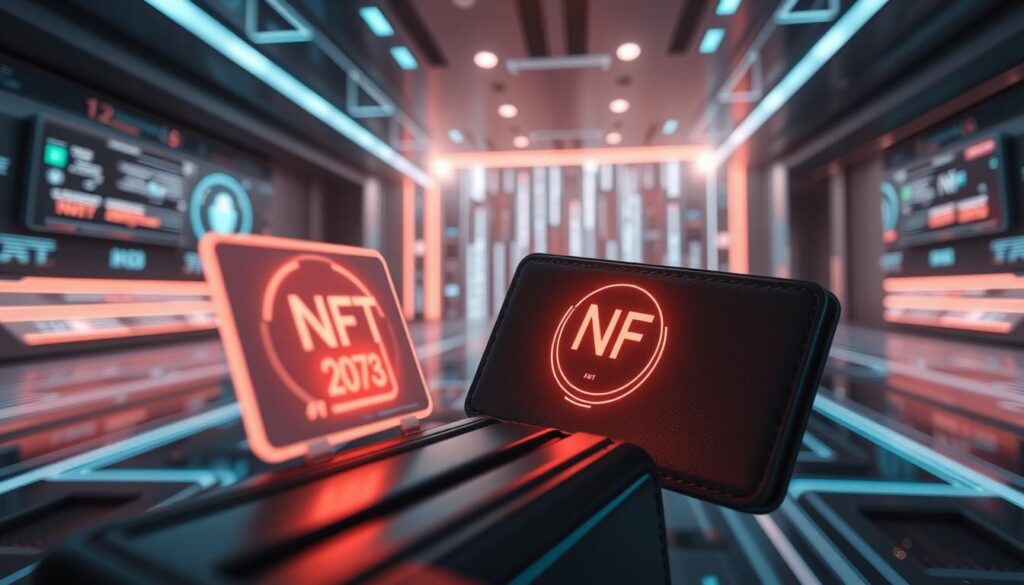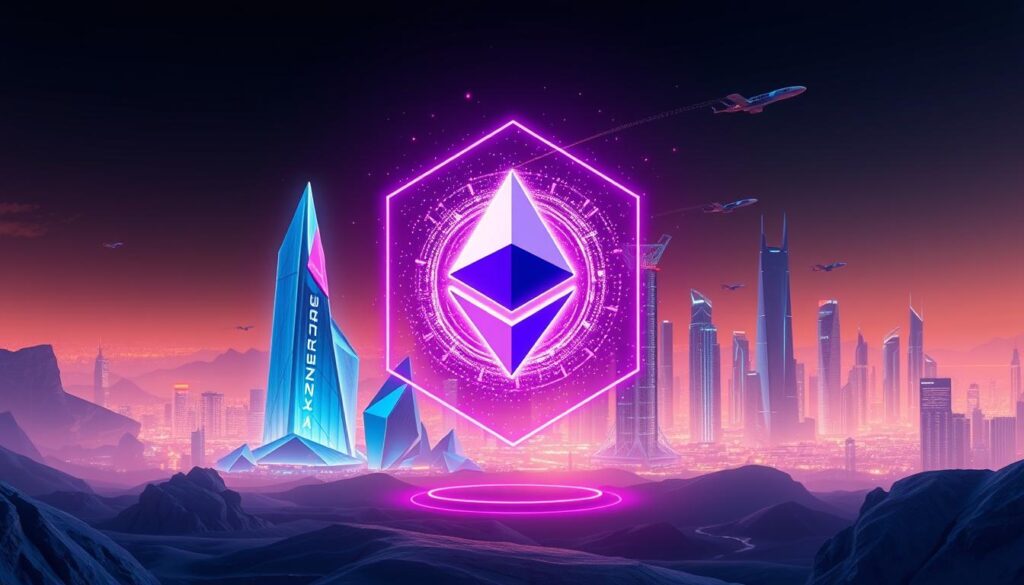Now Reading: How to mint NFTs on Ethereum Polygon and Solana blockchain networks
- 01
How to mint NFTs on Ethereum Polygon and Solana blockchain networks
How to mint NFTs on Ethereum Polygon and Solana blockchain networks

The rise of blockchain-based ownership has transformed how creators share and monetize their work. Unique digital items now serve as verifiable proof of authenticity, opening new opportunities for artists, musicians, and entrepreneurs. These assets thrive on decentralized networks, combining innovation with practical utility.
Converting files into blockchain-certified tokens involves technical steps and strategic planning. Costs vary widely between platforms, with factors like network congestion and energy efficiency shaping decisions. Savvy creators analyze gas fees, environmental impact, and audience preferences before selecting their preferred ecosystem.
Three leading platforms dominate this space, each offering distinct benefits. One prioritizes security and mainstream adoption, while another focuses on low-cost transactions. A third balances speed with scalability, appealing to high-volume projects. Understanding these differences ensures better alignment with creative goals and budgets.
This resource provides actionable insights for navigating the entire creation journey. From wallet setup to post-minting promotion, every phase gets detailed attention. Real-world case studies highlight successful strategies, helping readers avoid common pitfalls while maximizing their returns.
Key Takeaways
- Blockchain choice impacts costs, transaction speed, and environmental footprint
- Preparation includes digital wallets, platform research, and metadata optimization
- Gas fees fluctuate based on network activity and token standards
- Market trends influence collector demand and secondary sales potential
- Cross-chain compatibility expands audience reach and liquidity options
Introduction to NFT Minting on Blockchain Networks
Transforming digital files into unique assets is now possible through blockchain technology. This innovation allows creators to authenticate their work while giving collectors confidence in ownership. The process unlocks opportunities across industries, from art to virtual gaming.
Defining NFT Minting
NFT minting converts digital content into one-of-a-kind tokens stored on decentralized ledgers. Smart contracts automatically record details like ownership history and creation dates. Once completed, these records become permanent and tamper-proof.
Artists upload files—images, videos, or audio—to platforms that generate cryptographic proofs. These proofs verify authenticity, making each item distinct. Unlike traditional files, minted assets gain value through scarcity and provable originality.
The Rise of Digital Collectibles
Collectors now seek rare virtual items, driving demand for limited-edition drops. Musicians release exclusive albums as tokens, while brands create branded assets for loyal fans. This shift empowers creators to earn directly from their audience.
Blockchain’s transparency builds trust between buyers and sellers. Every transaction remains visible, reducing fraud risks. As digital collectibles grow mainstream, they reshape how we perceive value in the virtual space.
Understanding NFT Minting: Concept and Importance
Provenance tracking in the digital age ensures creators retain control over their work like never before. Unlike traditional digital files, minted assets carry embedded proof of origin, transforming casual uploads into certified valuables. This shift addresses long-standing issues of duplication and unauthorized distribution.

Establishing Ownership & Authenticity
Minting converts creative output into tamper-proof tokens using cryptographic verification. Each transaction gets logged permanently, creating an unbroken chain of custody. Collectors gain confidence knowing their purchases are verified originals, not copies.
Artists benefit from reduced piracy risks while maintaining intellectual property rights. The process eliminates middlemen, letting creators set royalty percentages for future sales automatically. This feature ensures ongoing revenue from secondary markets.
Blockchain’s public ledger allows instant verification of asset history. Buyers trace an item’s journey from initial creation to current ownership. Such transparency builds trust and justifies premium pricing for rare or iconic pieces.
For innovators, this system unlocks direct monetization paths. Musicians bypass streaming platforms, while designers sell limited-edition digital wearables. The technology reshapes creative economies by prioritizing creator rights and buyer assurance.
How to mint NFTs on Ethereum Polygon and Solana blockchain networks
Digital creators now wield unprecedented control over their work through blockchain integration. This technology anchors authenticity in every pixel and brushstroke, transforming ephemeral files into certified assets. Permanent ledgers record every change of hands, establishing clear provenance for collectors.

Transforming Creative Economies
Leading decentralized networks offer distinct frameworks for asset creation. One prioritizes security and legacy market integration, attracting high-value collections. Another combines speed with affordability, ideal for frequent drops. A third enables seamless cross-chain interactions, broadening distribution channels.
Fee structures directly impact profitability. Energy-efficient alternatives reduce upfront costs by up to 99% compared to traditional proof-of-work systems. These savings enable smaller creators to compete in crowded markets without compromising quality.
Programmable royalties redefine long-term earnings. Smart contracts automatically allocate percentages to original artists during resales. This feature ensures ongoing compensation, aligning incentives between creators and collectors.
Platform selection hinges on technical requirements and audience expectations. Some ecosystems support complex minting basics like interactive metadata, while others focus on mass adoption through user-friendly interfaces. Understanding these nuances helps artists maximize visibility and engagement.
Overview of Blockchain Platforms for NFT Minting
Selecting the right foundation for digital assets requires balancing costs and capabilities. Leading ecosystems cater to distinct creative needs while managing operational expenses. This comparison helps creators align technical requirements with financial realities.

High Value with Higher Transaction Costs
One dominant player attracts premium collections through established market presence and security. Its robust infrastructure supports complex smart contracts, ideal for high-stakes drops. However, network congestion often spikes processing fees beyond $500 during peak activity.
Artists prioritizing prestige over costs favor this environment. Royalty structures here typically yield better returns for established names. Collectors recognize its legacy status, often paying premiums for verified assets.
Budget-Friendly Ecosystems Emerge
Newer alternatives slash expenses through innovative consensus mechanisms. Layer-2 solutions maintain compatibility with major markets while reducing fees to fractions of a cent. Speed becomes their hallmark, processing thousands of transactions per second.
These networks excel for experimental projects and mass distributions. Emerging creators benefit from low entry barriers without sacrificing credibility. Environmental concerns also diminish with energy-efficient protocols.
Cross-chain tools now bridge once-separated communities. Artists can launch collections across multiple ledgers simultaneously. This strategy maximizes visibility while letting buyers choose preferred ecosystems.
Examining Gas Fees and Network Congestion
Navigating blockchain costs requires understanding dynamic pricing models that power digital transactions. These expenses fluctuate like surge pricing during rush hour, directly impacting creator budgets and collector accessibility.
Variability of Gas Prices
Gas fees act as bidding systems where users compete for validator attention. Popular chains experience midday price spikes comparable to stock market openings. Data shows weekend transactions often cost 40% less than weekday peak hours.
Ethereum’s average fee swung from $2.14 to $196 within 72 hours during a recent metaverse land sale. Such volatility makes real-time tracking essential. Free tools like Etherscan’s gas tracker help creators spot temporary price dips.
Strategies for Lower Transaction Costs
Three tactics reduce expenditure without compromising security:
- Schedule drops during low-activity periods (1:00-4:00 AM UTC)
- Use batch transactions to combine multiple actions
- Monitor marketplace fees alongside network charges
Layer-2 solutions offer fixed-rate pricing models, eliminating guesswork. Some platforms now absorb gas costs during promotional periods, shifting expenses to secondary sales. These innovations help emerging artists compete with established names.
Detailed Costs of NFT Minting Across Blockchains
Creators must navigate a maze of expenses when tokenizing their work. Prices swing wildly between networks, with hidden charges often catching newcomers off guard. Strategic planning separates profitable projects from financial sinkholes.
Transaction Fees and Smart Contract Costs
Network fees form the backbone of minting expenses. One major network charges $50-$500 per transaction during traffic spikes. Others maintain sub-cent fees year-round, appealing to budget-conscious artists.
Custom smart contracts add complexity. Deploying unique code increases initial setup costs by 15-30%. These investments pay off for large collections needing specialized functionality.
Platform and Marketplace Charges
Popular hubs take 2.5-3% cuts from every sale. These percentages compound over time, especially for high-value assets. Creators exploring Solana-based collections benefit from lower ongoing fees compared to legacy markets.
Mid-range networks offer balanced pricing. Options like Tezos ($0.50) and Cardano ($0.04-$0.39) attract creators seeking established ecosystems without premium costs. Each choice impacts long-term profitability and audience reach.
Step-by-Step Process to Mint Your First NFT
Launching digital collectibles starts with mastering core technical steps. Creators navigate platform interfaces while balancing artistic vision with technical requirements. Proper preparation prevents costly errors during this transformative process.
Setting Up Your Digital Wallet
Secure storage solutions like MetaMask or Coinbase Wallet form your creative toolkit’s foundation. These applications store cryptographic keys that prove ownership of digital assets. Always verify wallet compatibility with your chosen marketplace before proceeding.
Funding your account requires purchasing platform-specific cryptocurrency. Most networks accept credit card payments through integrated exchanges. Maintain a small test balance before initiating large transactions to understand fee structures.
Uploading Your Digital Asset
File preparation separates professional results from amateur attempts. Platforms typically accept JPG, PNG, or MP4 files under 100MB. Use editing software to optimize resolution without exceeding size limits.
Metadata fields demand strategic thinking. Titles and descriptions should contain relevant search terms while reflecting artistic intent. Royalty percentages between 5-10% ensure fair compensation for future resales.
Final confirmation screens display total costs before blockchain submission. Network congestion might delay transactions, but most complete within 15 minutes. Successful mints appear in both your wallet and marketplace profile instantly.
Leveraging Lazy Minting and Gasless Platforms
Emerging strategies in token generation prioritize flexibility and financial efficiency. Creators now bypass upfront expenses through delayed asset finalization, a process gaining traction across digital marketplaces. This evolution responds to fluctuating network demands while maintaining creator control.
Benefits of Delayed Minting
Delayed minting allows artists to list items without immediate blockchain confirmation. This approach eliminates gas fees until a sale occurs, preserving capital for promotional efforts. Platforms supporting this model often integrate royalty tracking from the first transaction.
Energy consumption drops significantly compared to traditional methods. Sellers retain full ownership rights during pre-sale phases. Market testing becomes risk-free with no upfront minting costs.
Potential Drawbacks to Consider
Platform reliability becomes critical with deferred processes. Technical failures could disrupt final tokenization steps. Some collectors view unminted items as less authentic than blockchain-anchored assets.
Royalty enforcement faces challenges if assets move across ecosystems. Always verify platform security protocols and redundancy measures. Backup solutions ensure asset preservation during unexpected outages.
Gasless options democratize access but may limit advanced customization. Weigh convenience against artistic requirements before committing to a workflow. Hybrid models now blend deferred costs with instant verification features.











